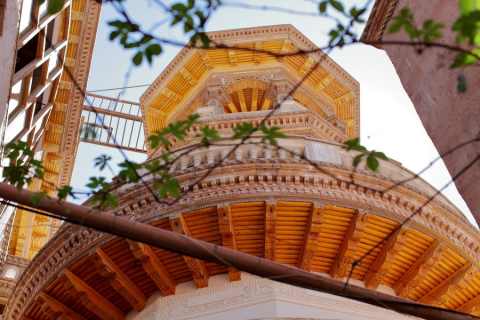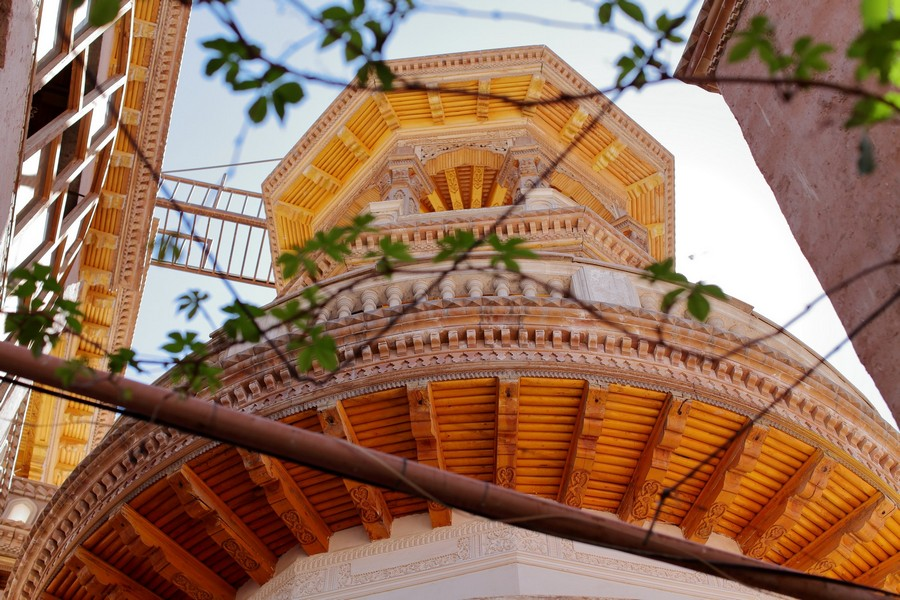

In today's information-rich world where everyone is well-informed, the ancient city is no longer a place with a halo. magic , Action-oriented words. If someone visits an ancient city one day, if there is no strange encounter, it is not worth writing about, and even fewer people will read it. It is hard to imagine that "ancient city" was once a hot word. People went to ancient cities to reminisce about the past, to relax, and to meet.
In this case, why does the ancient city of Kashgar attract us to make a special trip? It is our first stop in Xinjiang. Behind every choice, there are always some visible or invisible reasons. Our reason is that no one objects:
“Where are you going next month?”
"Let's go to Kashgar."
"good."
So, we just made the decision as usual, and then we started looking forward to a good time.



Mr. Ji Xianlin once said: "There is only one place in the world where the four major human civilizations, namely, Chinese civilization, Indian civilization, Roman civilization and Egyptian civilization, converge at one point. This point is not elsewhere, but in southern Xinjiang."
Mr. Ji was talking about southern Xinjiang, and I automatically substituted Kashgar - a crossroads of history and civilization, a book of sages worth reading over and over again. At the same time, civilization is buried in the sand and full of life.


I am a lover of ancient cities. Various "ancient cities" have tortured me thousands of times. I treat ancient cities like my first love. My trip to ancient cities started in Italy, with three ancient cities known all over the world: Rome, Venice, and Florence.
Venice, I am intoxicated by the fact that it is as beautiful as the picture album. In the photo back then, I looked silly, and my face was filled with the happiness of my dream coming true. In Venice in the summer, tourists are like crucian carp crossing the river. Even they have become the scenery in my eyes. I even learned to distinguish the nationality of the tourists: the tall one carrying a backpack is German, and the one carrying a camera is German. The British, the loud and always shirtless, are the Americans.
All day long, I was in a state of happiness and excitement, moved by "it's really Venice" or "Venice is real", the Grand Canal is real, Piazza San Marco is real, the pigeons are real, the church The endless ringing of bells is real, and the buildings and palaces on the water are real.
I was lost in the colorful and dazzling scenery, and the excitement lasted until the evening.


Thank God, there are no lighting projects in Venice at night, and it is not an exaggeration to describe it as "dark". We sat on the boat as the crowds faded and visited Venice at night.
After my eyes adapted to the darkness, I began to feel another side of Venice. The canals exuded the strong salty smell of the sea, and the dark buildings were as silent as the shore in the water. Venice was no longer a dazzling "travel souvenir", but decayed and decayed. , the water of the canal laps at the porch and steps of the building, and where the boat passes, the "palace" looks bare, dense, dim, and messy during the day.
This is also the real Venice. It was once a city that showed off its wealth. All kinds of things were brought here continuously: Greek columns, oriental spices, Persian carpets, Byzantine sundries, brocades, Gothic architecture and Renaissance artwork. Is all this culture or wealth? Can't tell. Venice gives people a complicated feeling. It is loved and criticized at the same time. Some people say that it is boring, superficial, and ostentatious, because it is only piled up without innovation. Its proud Baroque architecture, when in history When the real Baroque emerged, Venice was already beyond its reach.

I think the charm of Venice lies in this complex presentation. It is unique. It has experienced prosperity, decline, rise, fall and sinking.
No matter what kind of reviews, nothing compares to going there in person and feeling the smell and sound, as well as the happy tourists passing by.
I remembered another little thing in Rome. It was also at night, and we were queuing up to buy ice cream in the square in front of the Pantheon. The line was very long, and ice cream is very famous. In front of us was a young couple with four or five children. They looked exhausted. They bought an ice cream cone for themselves and their children. The children didn't want to eat it after two bites and stuffed the cones into their hands. Mom and Dad began to engage in more joyful chasing and fighting, so the young parents each held 3-4 ice creams in their hands, licking them endlessly in silence and helplessness. In Rome in the summer, it was very hot even at night, and they were playing with the ice cream. Melting speed race. Anytime I think about this scene I laugh until my stomach hurts.
This is my trip. Every street, every person, and every thing may remain in my memory. Only after a long time has passed, I will know which ones have been remembered by me and which ones have been forgotten.

When I was planning to write down what I saw and heard, I felt a little embarrassed to describe those trivial things.
I also have such concerns about Kashgar. It seems that I can't provide any valuable information, and I don't want to list the buildings in the city according to others. In fact, even I myself have not consulted such a guide.
In order not to miss any rare and beautiful things, my companions and I almost polished the soles of our feet in the ancient city with a radius of 3.5 kilometers. We were aimless and took things as they came. We looked at the bricks on the ground from time to time. If they were hexagonal, you could rest assured. If you go forward, you can always find an exit to another road. If it's a square brick, be prepared to turn back because it's a dead end. It seems that this is the only thing that needs to be paid attention to. For other things, eat when you should, drink when you should, strike up a conversation when you should, and take pictures when you should take pictures.

Some places we passed:
Next to the century-old teahouse is a hand-woven rug shop. There are many old objects with a long history. The old colors are burning, which is hotter and more charming than the new colors.


Suddenly a camel caravan passed by downstairs. Kashgar is the largest oasis city in the Central Asian desert. A camel caravan in the city is as normal as a herd of horses passing by in the grassland. However, I was fascinated, as if I had encountered a catwalk, no, it was more elegant and beautiful than a catwalk.


Local people living as usual:


Don't forget to look up occasionally, especially the flocks of pigeons at dusk. Dozens or hundreds of them fly by in formation, their white wings reflecting the sun's rays, as if they are rehearsing for a large performance.
By the way, an interesting thing happened when I looked up at the birds. Maybe it was because I looked so strange. After a while, several children surrounded me, and then more and more children surrounded me. Everyone looked up at the sky. , they said that pigeons were all over the sky looking for food. When pigeons flew over, the children would remind me loudly: Here they come, here they come!
They didn't help me. I couldn't take pictures of the pigeons, it was too noisy.
But it’s okay. Isn’t it more fun to play with children than to shoot pigeons? They asked me where I was going, and I pointed to the street sign and said I was looking for a free observation deck. The children immediately told me the truth: "It has been gone for a long time. It has been gone since I was a child." But they seemed to be all the same. No more than seven or eight years old.
When I left, the children were reluctant: "Can't you play for a while longer?" Just when I hesitated, I found that they had shifted their attention, okay, goodbye, little cuties.



After leaving the ancient city, I went to the Tomb of Xiang Fei alone to fulfill a small wish.
The Tomb of Xiang Fei is also called Apak Hoja Mazar. Apak Hoja was the leader of the Baishan sect of Islam in the mid-to-late 17th century. Based in Kashgar, he ruled six cities in southern Xinjiang and created the first theocratic "Hoja" regime south of the Tianshan Mountains. As the great-niece of Apak Hoja, Xiang Fei occupies a place in this prominent family cemetery where seventy-two people from five generations are buried.
The mausoleum, which is more than 20 meters high, has a square bottom and a hemispherical dome, with tall Bunker buildings standing at the four corners. The outer walls of the mausoleum are inlaid with green glazed bricks, mixed with blue and yellow, showing the solemnity of Islamic architecture. , steady and holy characteristics. There are also green Gongbei, high and low temples, gate towers, ponds, orchards and flower gardens.
Xiangfei's Tomb is very suitable for visiting alone at dusk, walking around the building and feeling the flow of air and energy. Historical stories and folklore have added to the charm of Xiangfei Tomb. Even as a place or a building, it is still beautiful.




On the way back to the hotel from Xiangfei's tomb, we encountered the sunset on the Tuman River. The river and the bridge were painted with a beautiful golden color, which is the original color of Kashgar, "the city of gold and jade." I stopped to watch the sunset and the Uyghur teenagers taking pictures of each other on the bridge. Generation after generation, tradition and reality. Kashgar is authentic and profound. It contains ancient personality in its mystery. It is also relaxed and free. No matter how anxious it is outside, we can find peace and tenderness in Kashgar. Even this unexpected sunset is not dazzling, but soothing and soft.


The next day we left Kashgar and headed to Ta County via Shufu, Wuqia and Akto counties.
Every day of the journey to southern Xinjiang was intoxicating. Compared to the beauty and clarity of the scenery, the text always seemed clumsy.
Thank you for being willing to listen to me continue to tell the story on the road. The next stop is the Pamir Plateau.
